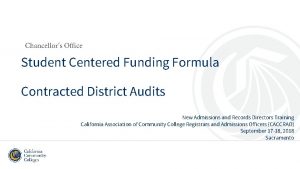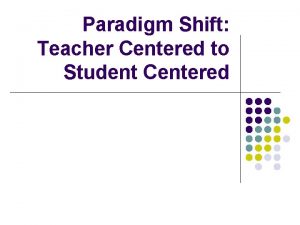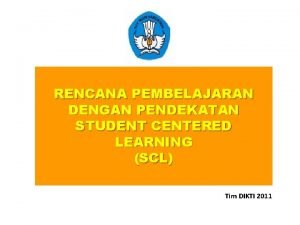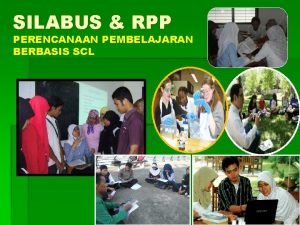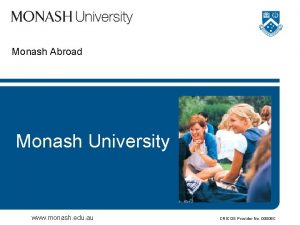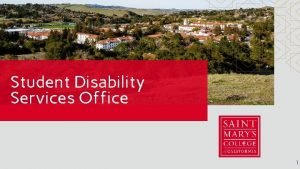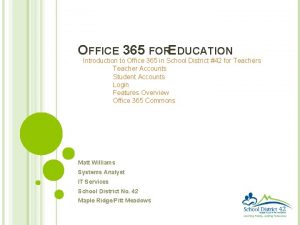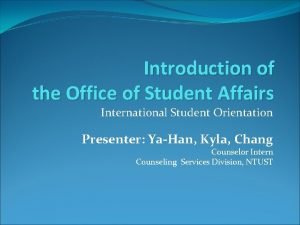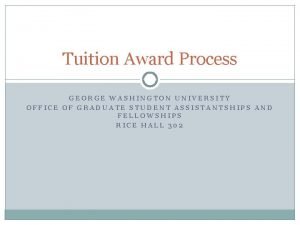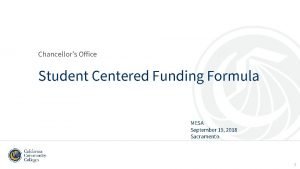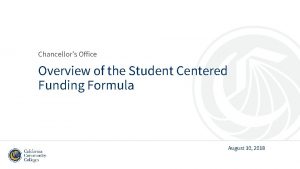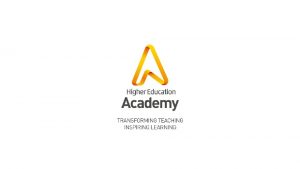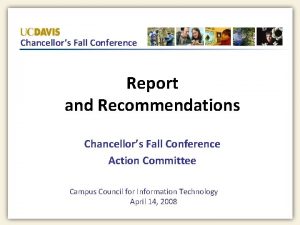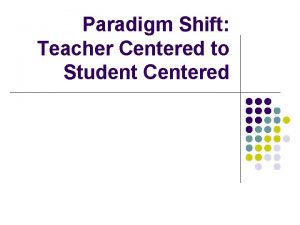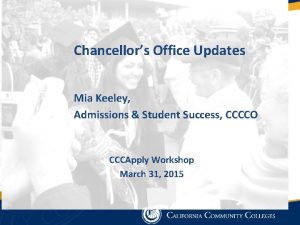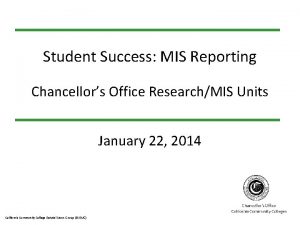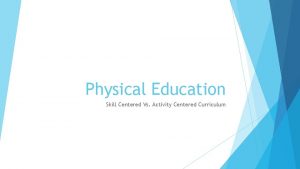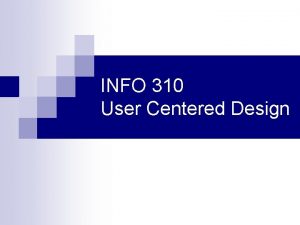Chancellors Office Discussion on the Student Centered Funding

























- Slides: 25

Chancellor’s Office Discussion on the Student Centered Funding Formula

Milestone “…California’s state leaders have truly delivered on a promise to put students first and set an example for the rest of the nation by adopting a new funding formula that incentivizes student success…” –Chancellor Eloy Ortiz Oakley

Overview Calculation Information Insights Regarding Future Actions Implementation Information

Principles for Reform • In reforming funding for community college districts, we should aim to do the following: • Encourage progress toward the Vision for Success adopted by the Board of Governors. • Provide groups of students that have faced barriers to success with additional support to meet our goals. • Make resources most useful to community college districts by making them stable, predictable, and flexible. • We want community college finance to further the activities the Chancellor’s Office is undertaking through the Guided Pathways framework.

Student Centered Funding Formula • The new formula calculates apportionments generally using three allocations: • Base Allocation— Current factors (primarily credit FTES). • Supplemental Allocation— Counts of low-income students. • Student Success Allocation— Counts of outcomes related to the Vision for Success , with “premiums” for outcomes of low-income students. • Under this structure, noncredit FTES and some credit FTES would be funded at current rates. • The rates are calculated to provide a three-year transition to the new funding rates.

New Elements—Supplemental Allocation • For the supplemental allocation, a district would receive one “point” based on the counts of all of the following in the prior year: • Pell Grant recipients. • California College Promise Grant recipients. • AB 540 students.

New Elements—Student Success Allocation

New Elements—Funding Rates

Funding Stability Provisions

Upcoming Deadlines

Alignment with Educational Programs • Districts are required to do the following: • Goals—Adopt, by January 1, 2019, of goals that are aligned with the Vision for Success. • Comprehensive Plans— Align comprehensive plans with those goals and alignment of annual budgets with the comprehensive plans. • Capacity—If directed by the chancellor (with approval by the Board of Governors), use funds for technical assistance or professional development.

Alignment with Educational Programs • The legislation also creates several new responsibilities for the Chancellor’s Office—specifically, the development of: • Processes to monitor the approval of new awards, certificates, and degree programs. • Processes to monitor the number of students who transfer to for-profit postsecondary educational institutions, with required reports on the growth of transfer to these institutions compared to transfer to the UC and the CSU. • Minimum standards for the approval of certificates and awards that would count toward the funding formula.

Alignment with Educational Programs • The 2018 -19 budget also established the Student Equity and Achievement Program—to provide districts with additional flexibility to support students, especially those with the greatest needs, in meeting the outcomes included in the Student Centered Funding Formula.

Implementation Team Chancellor’s Office Implementation Team • • • Board of Governors Legislature Governor Oversight Committee Advisory Groups

Implementation Team • To communicate how the implementation of the SCFF can advance the Vision for Success under the Guided Pathways framework. • To apportion funds consistent with the related statutes. • To align system policies and practices with these changes. • To support community colleges in implementing these policies by providing professional development and technical assistance. • To make decisions transparently and with advice from interested parties.

Oversight Committee • Budget legislation would create an oversight committee consisting of 12 members appointed by the Senate Rules Committee, the Assembly Speaker, and the Governor. • The committee would make recommendations: • By January 1, 2020, on use of measures (as part of the supplemental allocation) related to a student’s status as a first-generation college student, a student’s financial need given regional considerations, and a student’s academic proficiency. • By June 30, 2021, on funding for noncredit courses and instructional service agreements, as well as methods by which allocations could be adjusted in a recession.

Other Concerns • We have heard concerns that a district would not receive points in the student success allocation for the following: • A student who has completed a transfer-level mathematics course in the district and a transfer-level English course in another district (or vice versa). • A student who has taken some CTE units (less than nine) in the district and some CTE units (less than nine) in another district—even if those units total nine units or more. • A “special admit” student (generally a high school student in dual or concurrent enrollment) who has achieved outcomes included in the new formula (e. g. , completion of nine CTE units or completion of transfer-level mathematics and English within one year).

Other Concerns • In the student success allocation, we have also heard interest in: • Considering apprenticeship-related outcomes. • Refining the measure related to completion of nine or more CTE units. • Further, we have heard concerns that the formula might encourage districts to create new certificates or pathways that have limited value for the student, because formula allocates points in the student success allocation based on the total number of outcomes across the categories, with multiple outcomes achieved by the same student counted each time.

Advisory Workgroup on Fiscal Affairs • The Chancellor asked the Advisory Workgroup on Fiscal Affairs to lend expertise on the following: • The adoption of regulations that clarify the provisions of the related statutes. • The development of new reports, including apportionment reports, that reflect the formula and associated processes to collect data from districts. • The production of tools that would help business officials and other local leaders forecast revenues under the formula, including new multi-year planning tools. • The Chancellor also asked for appointment of members who serve in other roles, including a CEO, CIO, CSSO, faculty member, and student.

California Budget Process Adoption of BOG Request Release of Governor’s Budget Legislative Analyst’s Analysis Budget Subcommittee Hearings Governor’s Revisions Budget Subcommittee Actions Conference Committee Legislative Actions Governor’s Consideration Implementation

Budget and Legislative Request • A primary component of the budget and legislative request for 201920 approved by the Board of Governors is an increase an appropriations for the Student Centered Funding Formula. The costs of a 5 -percent adjustment are estimated to be $345 million. • In addition, the board is requesting: • $250, 000 in 2019 -20 and 2020 -21 ($500, 000 total) for support of oversight committee. • $250, 000 in 2019 -20, 2020 -21, and 2021 -22 ($750, 000 total) for evaluation.

Budget and Legislative Request • The Board of Governors is also requesting a 5 -percent increase in funding for the Student Equity and Achievement Program, amounting to $23 million (in addition to the $475 million currently budgeted). • Further, the board is requesting authority to establish a methodology for allocation of these funds—a formula that should create appropriate financial incentives for meeting the goals in the Vision for Success.

Resources to Support Implementation • Through Guided Pathways, the Chancellor’s Office is supporting districts in making changes to improve student success. Specifically: • Professional Development • Vision Resource Center • Regional Coordinators • We are also encouraging leaders to participate in upcoming Guided Pathways workshops.

Upcoming Events • There also two upcoming SCFF webinars: • Linking to Local Goals—November 5, 2018, 2: 00 pm to 3: 30 pm • Strengthening Student Equity and Achievement—December 2018 • The Chancellor’s Office team will also be presenting at many conferences and events this fall—let us know if there are places we should be!

More Information To receive responses to questions or to provide comments on implementation, please email SCFF@cccco. edu. To Chancellor’s Office will post updates, including responses to frequently asked questions, at http: //extranet. cccco. edu/Divisions/Finance. Facilities/Student. Centered. Funding. Formula. aspx.
 Student centered funding formula
Student centered funding formula Stock image
Stock image Chancellors school
Chancellors school Rpp berbasis scl
Rpp berbasis scl Contoh rpp berbasis student centered learning
Contoh rpp berbasis student centered learning Discussion of simple distillation
Discussion of simple distillation Student-led discussion assignment
Student-led discussion assignment How did you...your last weekend
How did you...your last weekend What did you do over the weekend
What did you do over the weekend Uheaa contact
Uheaa contact Class maths student student1 class student string name
Class maths student student1 class student string name National student clearinghouse student tracker
National student clearinghouse student tracker Https://student.freckle.com/#/fact-practice
Https://student.freckle.com/#/fact-practice Good morning campers todays challenge is simple
Good morning campers todays challenge is simple Student leaning space
Student leaning space Monash abroad
Monash abroad Student disability services (sds) office
Student disability services (sds) office Me sd42
Me sd42 Student affairs office
Student affairs office George washington university student accounts
George washington university student accounts Hình ảnh bộ gõ cơ thể búng tay
Hình ảnh bộ gõ cơ thể búng tay Slidetodoc
Slidetodoc Bổ thể
Bổ thể Tỉ lệ cơ thể trẻ em
Tỉ lệ cơ thể trẻ em Chó sói
Chó sói Thang điểm glasgow
Thang điểm glasgow
